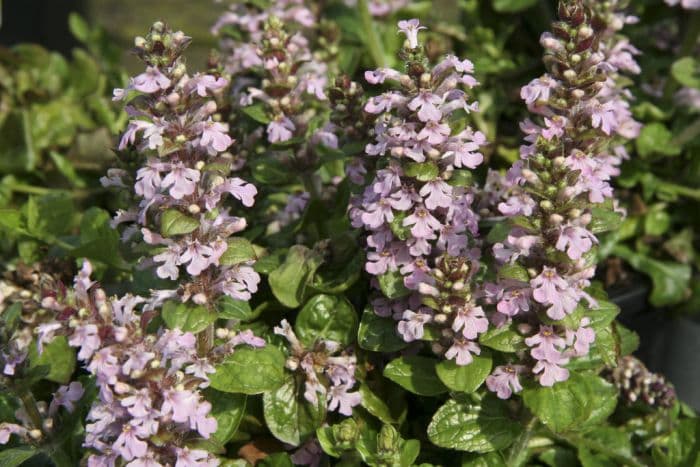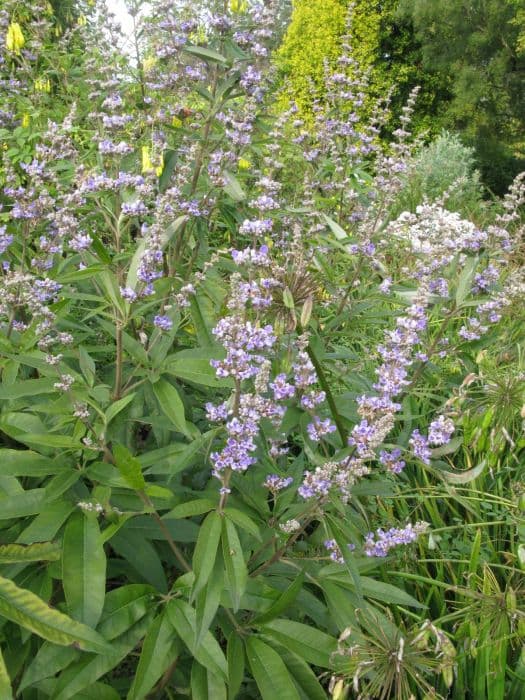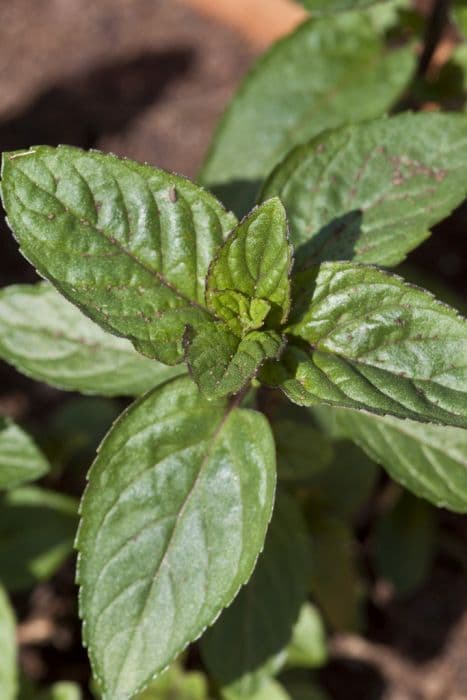Bugleweed Ajuga reptans 'Purple Torch'

ABOUT
The Ajuga reptans 'Purple Torch', commonly known as Bugleweed, is a perennial plant celebrated for its vibrant foliage and attractive flowering spikes. The leaves of Bugleweed are typically rich green to deep burgundy-purple, providing a striking contrast when planted among lighter-colored plants. Each leaf is oval-shaped with a rounded tip and a subtle sheen, accompanied by a texture that can be described as both firm and lush. During its blooming period, Bugleweed produces upright spikes on which tubular flowers are densely packed. These flowers are often a deep blue or violet hue, and they rise elegantly above the foliage. The visual impact of these floral spires is eye-catching, as they add both color and vertical interest to the plant's overall appearance. The growth pattern of Bugleweed is spreading and mat-forming, which allows it to create a lush, ground-covering carpet in the landscapes where it is planted. Its overall presence is one of a hardy plant with an ornamental allure that is simultaneously bold and delicate. While this plant is relatively low-maintenance, it thrives best when given the proper growing conditions, which includes adequate sunlight and moist soils. This allows Bugleweed to showcase its quintessential charm with both its colorful leaves and blossoms, making it a favorable choice for gardeners looking to add both texture and a splash of color to their outdoor spaces.
About this plant
 Names
NamesFamily
Lamiaceae.
Synonyms
Bugleweed, Carpet Bugle, Common Bugle, Blue Bugle.
Common names
Ajuga purpurea, Ajuga repens, Bugula reptans, Bugle reptans, and Teucrium repens.
 Toxicity
ToxicityTo humans
Bugleweed is not generally considered to be toxic to humans. There is limited information about the toxicity of this plant to humans, so it is always advised to err on the side of caution and not consume any parts of plants unless they are known to be safe. If Bugleweed was ingested and any adverse symptoms are experienced, it is important to seek medical attention.
To pets
Bugleweed is not commonly listed as a toxic plant to pets. However, individual animals may have different sensitivities, and it is always prudent to prevent pets from eating ornamental plants. If a pet ingests Bugleweed and shows any signs of illness such as vomiting, diarrhea, or unusual behavior, contact a veterinarian immediately.
 Characteristics
CharacteristicsLife cycle
Perennials
Foliage type
Evergreen
Color of leaves
Purple
Flower color
Blue
Height
6-10 inches (15-25 cm)
Spread
12-18 inches (30-45 cm)
Plant type
Creeper
Hardiness zones
3-9
Native area
Europe
Benefits
 General Benefits
General Benefits- Ground Cover - Ajuga reptans 'Purple Torch', commonly known as bugleweed, provides a dense mat that suppresses weeds and covers unsightly bare spots in the garden.
- Ornamental Foliage - Its attractive, glossy purple leaves add color and depth to the landscape throughout the year.
- Drought Tolerance - Once established, it has good drought tolerance, reducing the need for frequent watering.
- Attracts Pollinators - The plant produces flowers that are appealing to bees and butterflies, helping to support local ecosystems.
- Low Maintenance - Bugleweed requires minimal care once it is established, making it a good choice for gardeners looking for an easy-to-care-for plant.
- Rapid Growth - It spreads quickly, filling in areas and creating a full, lush garden aesthetic in a short amount of time.
- Erosion Control - Its mat-forming habit can help prevent soil erosion on slopes or in areas where this may be a concern.
- Winter Interest - Some foliage remains attractive during the winter, offering visual interest in an otherwise dormant garden.
- Versatility - It's suitable for a variety of garden settings such as borders, rock gardens, and woodland gardens.
- Tolerates Foot Traffic - The plant can withstand light foot traffic, making it a good choice for planting between stepping stones or in a lawn alternative mix.
 Medical Properties
Medical Properties- This plant is not used for medical purposes.
 Air-purifying Qualities
Air-purifying QualitiesThis plant is not specifically known for air purifying qualities.
 Other Uses
Other Uses- Ajuga reptans 'Purple Torch', commonly known as bugleweed, can be used for erosion control on slopes due to its dense mat-forming habit which helps hold the soil in place.
- Bugleweed's vibrant foliage and flowers can be used in floral arrangements to add unique colors and textures.
- The plant can serve as a living mulch in gardens, helping to retain soil moisture and suppress weeds.
- Bugleweed can be used as a ground cover in shaded areas where grass might struggle to grow.
- The dense foliage of bugleweed provides excellent habitat for beneficial insects and small wildlife within a garden ecosystem.
- When planted alongside ponds or water features, bugleweed can help in establishing a natural and visually appealing transition between water and land.
- Some crafters use the dried leaves and flowers of bugleweed in potpourri for their texture and subtle color.
- Bugleweed can be used in theme gardens, such as fairy gardens or miniature landscapes, due to its low-growing and spreading nature.
- In large outdoor containers, bugleweed can be intriguing as a "spiller" plant, with stems cascading over the edge to add lushness and fullness.
- Bugleweed may also be included in green roof plantings where its hardiness and low maintenance make it a suitable choice for the challenging conditions of rooftop gardens.
Interesting Facts
 Feng Shui
Feng ShuiThe Bugleweed is not used in Feng Shui practice.
 Zodiac Sign Compitability
Zodiac Sign CompitabilityThe Bugleweed is not used in astrology practice.
 Plant Symbolism
Plant Symbolism- Persistence: Ajuga reptans, commonly known as Bugleweed, spreads quickly and can thrive in a variety of conditions, symbolizing an enduring nature and the ability to persist through challenges.
- Protection: Historically, some cultures believed that Bugleweed had protective qualities, possibly due to its medicinal uses, representing a symbol of safeguarding oneself or others.
- Consistency: With its ability to provide dense ground cover and remain evergreen in many regions, Bugleweed symbolizes constancy and reliability.
- Healing: Due to its traditional use in herbal medicine to treat various ailments, Bugleweed can be seen as a symbol of healing and restoration.
 Water
WaterCarpet Bugle should be watered deeply enough so that the water reaches the roots, approximately once or twice a week depending on weather conditions. During periods of drought or hot weather, increase watering frequency to ensure the soil remains moist but not waterlogged. A good rule of thumb is to provide about one to two inches of water per week. Less frequent but thorough watering encourages deeper root growth and can make the plant more drought tolerant. Always check the top inch of soil for dryness before watering as overwatering can lead to root rot.
 Light
LightCarpet Bugle thrives best in partial to full shade, which makes them ideal for woodland gardens or as ground covers under trees. They can tolerate some morning sun, but in regions with strong sunlight, shield them from the harsh afternoon rays. A spot that offers dappled sunlight throughout the day is optimal, which can be provided by planting them under a canopy of trees with filtered light.
 Temperature
TemperatureCarpet Bugle is hardy and can withstand a range of temperatures, but it flourishes in conditions between 60 and 75 degrees Fahrenheit. They can tolerate winter cold down to about -20 degrees Fahrenheit but should be protected from severe cold winds. During the summer, ensure they have adequate shade if temperatures rise above 80 degrees Fahrenheit to prevent scorching of the leaves.
 Pruning
PruningCarpet Bugle requires minimal pruning, mainly to maintain its appearance and health. Trim back any dead or damaged foliage in early spring to encourage new growth. If desired, after the plant flowers, cut back the flower spikes to keep the planting neat and to possibly encourage a second flush of blooms. The best time for general pruning is in the spring or immediately after flowering.
 Cleaning
CleaningAs needed
 Soil
SoilBugleweed thrives in well-draining soil rich in organic matter with a pH ranging from 6.5 to 7.5. A mix of garden soil, compost, and peat moss is ideal for this plant.
 Repotting
RepottingBugleweed is not commonly repotted as it is a ground cover that prefers to spread out. Repotting is rarely necessary unless for division.
 Humidity & Misting
Humidity & MistingBugleweed is adaptable to a wide range of humidity levels and does not have specific humidity requirements. It grows well in average outdoor humidity.
 Suitable locations
Suitable locationsIndoor
Place bugleweed in bright indirect light, water moderately.
Outdoor
Plant in partial shade, water regularly, allow to spread.
Hardiness zone
3-9 USDA
 Life cycle
Life cycleBugleweed 'Purple Torch', a perennial herb, starts its life cycle with seed germination in favorable conditions of moisture and temperature, typically in spring. Seedlings develop into rosettes with a central cluster of leaves, expanding by producing creeping stolons that root at nodes to form new plantlets. Throughout spring and summer, the plants grow vegetatively, with lush purple foliage and preparing for the next stage. By late spring to early summer, Bugleweed 'Purple Torch' flowers, producing purple to violet flower spikes that attract pollinators, and after pollination, seeds develop. As the flowering phase ends, the plant focuses energy on strengthening the roots and stolon system for survival. In winter, Bugleweed 'Purple Torch' enters dormancy, with above-ground parts dying back in colder climates, while the roots and stolons survive underground to restore growth in the next spring.
 Propogation
PropogationPropogation time
Spring-Early Summer
Ajuga reptans 'Purple Torch', commonly known as bugleweed, is most commonly propagated by division. This simple method involves gently separating the plant's rooted sections during its active growth period, which is typically in the spring or fall when temperatures are mild. To propagate bugleweed by division, carefully dig up an established clump and use your hands or a sharp knife to divide the root ball into smaller sections, ensuring that each new section has at least a couple of healthy leaves and roots. Replant these divisions at the same depth they were growing at previously, spacing them about 6 to 12 inches (15 to 30 centimeters) apart to allow room for growth. Water the new plantings well to help establish them. This method leverages the plant's natural tendency to form dense mats and can quickly produce new plants that will bloom in subsequent seasons.









